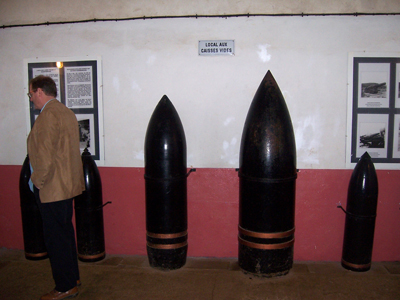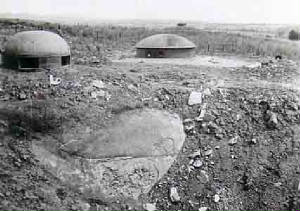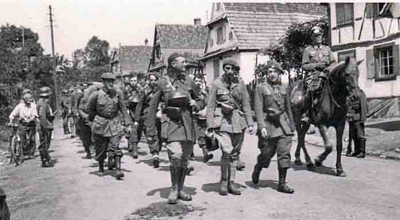
WWII: Maginot Line | Normandy | V-Weapon Sites | Arnhem
Further afield: Crete
| Home Tracing Military Ancestors Travel Advice CWGC Cemeteries Iron Harvest News Book Reviews Glossary Links Contact Me Maginot Line:
 
|
Ouvrage de Schoenenbourg in ActionOn 10th May 1940, the Germans invaded Belgium and Holland with their main armoured thrust aimed at France through the Ardennes. Four days later, far to the south-east of the main German attack, Schoenenbourg fired its first shots in anger on 14th May. The firing was immediately answered by German 280mm artillery – 13 shells landing on the fort at a range of 16˝ kilometres. The following day a further 20 of these enormous shells hit the fort and the surrounding area. This intermittent bombardment lasted up to 20th June with the fort using its own 75mm guns to provide covering fire for nearby casemates coming under direct attack. This constant period of action began to use up the stocks of 75mm shells in the magazines and, despite a re-supply operation on the night of 27th/28th May, ammunition continued to be consumed remorselessly. On 20th June, in a determined bid to break the resistance of the Ouvrage de Schoenenbourg, the Germans brought up an even heavier 420mm howitzer designed to shatter even the deepest concrete emplacements. The attack commenced at 8:00am when Stuka dive-bombers and Heinkel 111 bombers dropped a succession of 500kg and 1,000kg bombs on the fort. Debris covered the retractable turrets, which had to be cleared during the night, although no serious damage was sustained. The following day saw more air raids by the Stukas. However, apart from a few cracks in the concrete of Combat Block 6, they caused only superficial damage. Then, in the late afternoon, the huge 420mm howitzer opened up sending a 1,020kg shell at the fort every seven minutes. On the 21st and 22nd June this artillery piece fired a total of 28 anti-concrete shells onto the fort, each creating a 20 metre wide crater. A 355mm howitzer joined this “Big Bertha” with the two big guns firing alternately.
The firing continued for the next three days, during which the bombardment was joined by German 88mm, 105mm and 150mm guns. All the weight of fire that the Germans could muster was trained on Schoenenbourg and still its Combat Blocks were largely intact and its 75mm guns still firing.
It was only in the early morning of 25th June with the signing of the Armistice by the French Government, following their total victory of the German panzers to the west, that the guns fell silent. Even then, it was only on 1st July after an order was received from the French High Command to surrender, that the garrison, led by their valiant commander Chief of Battalion Reynier, left the fort and entered captivity.
Yet the garrison of Schoenenbourg had no reason to hang their heads in shame. Not only had the fort resisted exactly as planned – the concrete combat blocks proving impervious to even the heaviest artillery in Hitler’s armoury, but it had also continued to return fire against the enemy throughout the German attack. Indeed, between the 14th and 25th June 1940, Schoenenbourg fired 12,776 rounds from its 75mm guns and 612 rounds from its 81mm mortar. The garrison of Schoenenbourg may have been ordered to lay down their arms, but the fort still stood defiant as it does to this day. |


